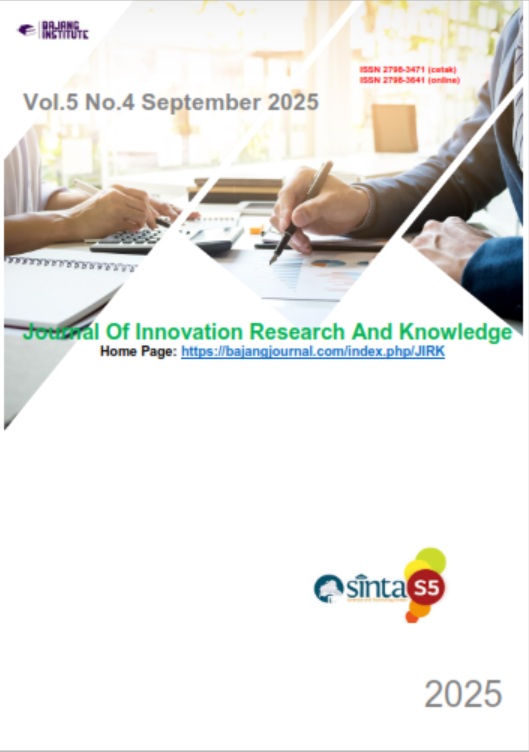ANALISIS PERBANDINGAN SNR DAN CNR PADA CITRA DIGITAL RADIOGRAPHY KEPALA NON KONTRASMENGUNAKAN METODE PENGOLAHAN CITRA PHYTON
DOI:
https://doi.org/10.53625/jirk.v5i4.11194Keywords:
SNR, CNR, Phyton ImageAbstract
Background: This study compares SNR and CNR in non-contrast head X-rays using Python. Head image quality is crucial due to its complex anatomical structure and the importance of small details in determining a diagnosis. Python is used to objectively analyze image clarity, read medical data, calculate SNR and CNR values, and display the results visually. This research is expected to help physicians obtain clearer images, accelerate diagnoses, and improve the quality of radiology services. Methods: This research was conducted at the Radiology Laboratory of Aisyiyah University Yogyakarta from March to May 2025. The subjects used were not live patients, but rather cranium phantoms, which are artificial models of human heads typically used for training or research to ensure safety. In this study, three different X- ray settings were used: 70 kV 10 mAs, 75 kV 12 mAs, and 80 kV 15 mAs. Each setting produced head X-rays with varying levels of brightness and sharpness. The images were saved in a medical-specific format called DICOM. Next, the images were analyzed using the Python programming language through the Google Colab platform. This analysis was carried out to calculate two important things: SNR (Signal-to-Noise Ratio), which describes how clear the image signal is compared to interference or "noise," and CNR (Contrast-to-Noise Ratio), which indicates how easy it is to distinguish two tissues or parts in the image. This calculation was carried out both before and after the image was improved through the image enhancement process. In this way, researchers can assess whether image processing actually makes head X-rays clearer and more useful for medical diagnosis. Results: The results showed that after image processing with Python, the SNR values increased in some settings, resulting in cleaner images, but the CNR values decreased in all images. This means that although the images appear sharper and clearer visually, the ability to distinguish anatomical structures is reduced. Therefore, improving visual quality through image enhancement does not always translate into improved diagnostic quality, requiring caution when applying it to radiology. Conclusion: The conclusion of this study is that processing non-contrast head radiographic images using Python can improve the SNR value in several parameter variations, so that the image appears cleaner from noise interference. However, the CNR value tends to decrease in all variations, which means the ability to distinguish anatomical structures is reduced. This shows that increasing visual acuity of the image is not always directly proportional to improving diagnostic quality, so image enhancement techniques need to be applied carefully to maintain a balance between image clarity and clarity of anatomical details to support medical diagnosis
References
Arifah, A. N., Kartikasari, Y., & Murniati, E. (N.D.-B). Comparative Analysis Of The Value Of Signal To Noise Ratio (Snr) At Mri Ankle Joint Examination Using Quad Knee
Coil And Flex/Multipurpose Coil. In Jimed
(Vol. 3, Issue 1).
Astria, R., Lasiyah, N., & Mulyadi, R. (2024). Analisis Kualitas Citra Radiografi Cr Dengan Signal To Noise Ratio (Snr) Dan Contras To Noise Ratio (Cnr) Menggunakan Microdicom. In Interdisciplinary Journal Of Medtech And Ecoengineering (Ijme) Doi (Vol. 1, Issue 1).
Endang Purnama Giri, S. H. W. & T. H. (2023). Pengantar Pemrograman Dengan Python Untuk Penelitian Menggunakan Anaconda Dan Jupyter Notebook.
Gede Puja Satwika, L., Nyoman Ratini, N., Iffah, M., Teknik Radiodiagnostik Dan Radioterapi Bali, A., & Tukad Batanghari
VII No, J. (N.D.). Pengaruh Variasi Tegangan Tabung Sinar-X Terhadap Signal To Noise Ratio
(SNR) Dengan Penerapan Anode Heel Effect Menggunakan Stepwedge Effect Of X-Ray Tube Voltage Variation On Signal To Noise Ratio (SNR) By Application Of Anode Heel Effect Using Stepwedge.
Huda, A., & Ardi, N. (N.D.). DASAR-DASAR PEMROGRAMAN BERBASIS PYTHON.
Huda, W., & Abrahams, R. B. (2015). X-ray-based medical imaging and resolution. American Journal of Roentgenology,204(4), W393- W397.
Louk, A. C., & Suparta, G. B. (2014). Pengukuran Kualitas Sistem Pencitraan Radiografi Digital Sinar-X Quality Measurement Of Imaging System Of X-Ray Digital Radiography (Vol. 24, Issue 2).
Muh Rifki Mustafa, I. A. N. L. D. W. (2025). Analisis Perbandingan Kualitas Citra Radiografi Abdomen Dengan Menggunakan Teknologi Virtual Grid Dan Physical Grid. Jurnal Kesehatan Tambusai, 6(1).
Ningtias, D. R., Wahyudi, B., & Harsoyo, I. T. (2022). Comparative Test Of The Effect Of X-Ray Tube Current Analysis And Exposure Time On Cr (Computed Radiography) Image Quality. Journal Of Informatics And Telecommunication Engineering, 6(1), 267–275. Https://Doi.Org/10.31289/Jite.V6i1.7334.
Nugraheni, F., Anisah, F., & Susetyo, G. A. (N.D.). Prosiding SNFA (Seminar Nasional Fisika
Dan Aplikasinya) 2022 Analisis Efek Radiasi Sinar-X Pada Tubuh Manusia.
Nugroho Ec, S. A. I. (2012). Pengembangan Program Pengolahan Citra Untuk Radiografi Digital.
Http://Journal.Unnes.Ac.Id/Nju/Index.P hp/Upej.
Nurvan, H., Kesuma Wardani, A., Palupi, N. E., Sakit, R., & Bekasi, A. B. (2023). ARTIKEL
PENELITIAN Karakteristik Pemeriksaan Pasien Di Instalasi Radiologi Rumah Sakit Ananda Babelan Bekasi Periode Agustus 2021-Juli 2022 :StudiRetrospektif. Https://Jurnal.Umsu.Ac.Id/Index.Php/JPH.
Priyono, S., Anam, C., & Wahyu Setia Budi, Dan. (2020). Pengaruh Rasio Grid Terhadap Kualitas Radiograf Fantom Kepala (Vol. 23, Issue 1).
Rani Rahmawati Wagola Ike Ade Nur Liscyaningsih, S. N. D. (2025). Analisis Perbandingan Kualitas Citra Radiografi Crnium Dengan Menggunakan Teknologi Virtual Grid Dan Physical Grid. Jurnal Kesehatan Tambusai.
Yosainto Bequet, A., Nurcahyo, P. W., Sulistiyadi,
A. H., & Bequet, A. Y. (2022). Jurnal Imejing Diagnostik Efektifitas Penambahan Source To Image Distance (SID) Terhadap Penurunan Dosis Radiasi Pada Pemeriksaan Radiografi Cranium. Jurnal Imejing Diagnostik, 8, 11–14. Http://Ejournal.Poltekkes- Smg.Ac.Id/Ojs/Index.Php/Jimed/Index
Gonzalez, R. C., & Woods, R. E. (2018).Digital Image Processing (4th Ed.). Pearson.
Mustafa, M. R., & Ike, I. (2024). Analisisperbandingan Kualitas Citra Radiografi Abdomen Menggunakan Physical Grid Dan Virtual Grid. Jurnal Kesehatan Terpadu, 12(1), 45–52.
Wibowo, N. P. E., Susilo, S., & Sunarno, S. (2016). Uji Profisiensi Citra Hasil Eksposi Sistem Radiografi Digital Di Laboratorium Fisika Medik Unnes. Unnes Physics
Journal, 5(1), 23-29.
Badan, K. (2018). Kepala Badan Pengawas Tenaga Nuklir Republik Indonesia.
Bontranger, K., & Lampignano, J. (2018). Bontranger's Textbook Of Radiographic Positioning And Related Anatomy (Vol. 9). Missouri: Elsevier.
Martinsen, A. C. T., & Saether, H. K. (2017). The Impact Of Image Processing On Radiographic Images: An Overview. Radiography, 23(2), E47–E52.
Ningtias, DR, Wahyudi, B., & Harsoyo, IT (2022). Uji Perbandingan PengaruhAnalisis
Arus Tabung Sinar-X Dan Waktu Paparan Terhadap Kualitas Citra CR (Computed Radiography). Jurnal Teknik Informatika Dan Telekomunikasi , 6 (1), 267-275.
Astria, R. (2024). Analisis Kualitas Citra Radiografi CR Dengan Signal To Noise Ratio (SNR) Dan Contrast To Noise Ratio (CNR) Menggunakan Microdicom. Interdisciplinary Journal Of Medtech And Ecoengineering (IJME), 1(1), 1–9.
Satwika, L. G. P., Ratini, N. N., & Iffah, M. (2021). Pengaruh Variasi Tegangan Tabung Sinar-X Terhadap Signal To Noise Ratio (SNR) Dengan Penerapan Anode Heel Effect Menggunakan Stepwedge. Buletin Fisika Vol, 22(1), 20-28.
Utami, A. P., Saputro, S. D., & Felayani, F. (2018). Radiologi Dasar I. Magelang. Penerbit Inti Medika Pustaka.
Warisan, AY, Nurcahyo, PW, & Sulistiyadi, AH (2022). Efektifitas Penambahan Source To Image Distance (SID) Terhadap Penurunan Dosis Radiasi Pada Pemeriksaan Radiografi Cranium. Jurnal Imejing Diagnostik (Jimed) , 8 (1), 11-14.
Ardoni13, F., Choridah, L., Susanto, E., & Irsal,M. (2023). Radiation Dose And Image Quality With Exposure Factor Variation Using A Virtual Grid In Digital Radiography. Digital Radiography. International Journal Of Scientific Research In Science And Technology 323-331.
Bequet, A. Y., Nurcahyo, P. W., & Sulistiyadi, A.H. (2022). Efektifitas Penambahan Source To Image Distance (SID) Terhadap Penurunan Dosis Radiasi Pada Pemeriksaan Radiografi Cranium. rnal Imejing Diagnostik (Jimed), 8(1), 11-14.
Nurvan, H., Wardani, A. K., & Palupi, N. E. (2023). Karakteristik Pemeriksaan Pasien Di Instalasi Radiologi Rumah Sakit Ananda Babelan Bekasi Periode Agustus 2021–Juli 2022: Studi Retrospektif. Jurnal Pandu Husada, 4(4), 1–14.Nuridzati, A., 1,
Susanto, E., 2, Rasyid, 3, Daryati, S., 4, Kurniawati, A., & 5. (2020). Jurnal Imejing Diagnostik. Jurnal Imejing Diagnostik Jimed),6,103.













